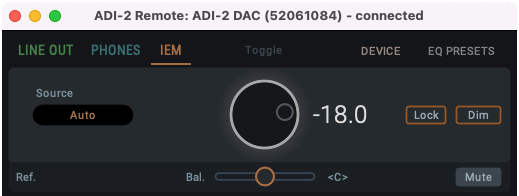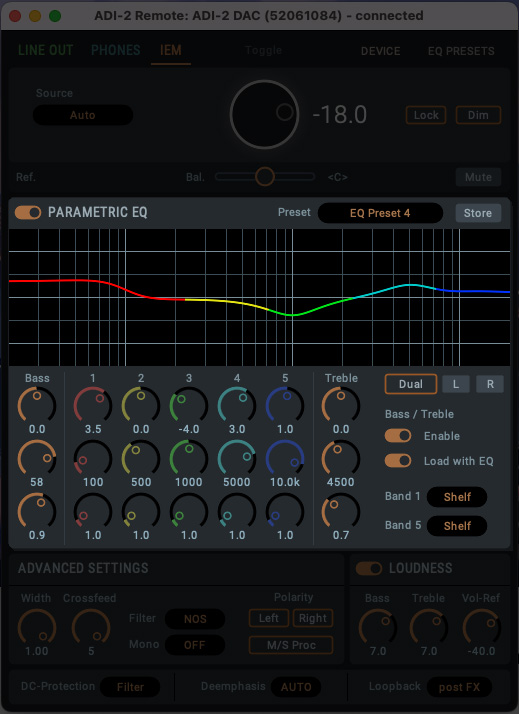RME ADI-2 DAC Premium 768 kHz DA converter med DSP
Er du på jakt etter en meget bra DA konverter for din stue eller studio? Da kan vi anbefale RME ADI-2 DAC. Denne har blitt testet av mange magasiner og eksperter med unisone toppkarakterer fra alle. RME ADI2 DAC er en Premium 768 kHz DA-konverter med DSP for tilpassing. Den har også meget kraftig hodetelefonutgang og IEM-utgang.
The ADI-2 DAC includes an improved SteadyClock, a fine-tuned to perfection analog circuitry, new MRC remote control, Extreme Power headphone output and a very special IEM output. It has all the bells and whistles that made the ADI-2 Pro famous, including its perfectly transparent sound signature and full DSP processing with Bass, Treble, Loudness, 5 Band Parametric EQ, Crossfeed and much more. With its simplified operation and stunning design it is the ideal center piece from home listening up to studio reference playback.
ADI-2 DAC er allerede en stormende suksess for RME. Med sine fantastiske spesifikasjoner vinner den gang på gang flotte lovord i Hifi fagpressen. Den ble kåret har vunnet «Årets Beste» DAC konverter i Lyd&Bilde 2019. RME ADI-2 DAC er en høykvalitets AD/DA omformer som er ideell for både Hi-Fi og hjemmebruk. ADI-2 DAC er en av de mest allsidige DAC-enhetene som er tilgjengelig, og tilbyr en rekke tilkoblingsmuligheter, inkludert 2 Extreme Power hodetelefonutganger. Den har DSP-behandling med bass, diskant, volume, 5-bånds parametrisk EQ, crossfeed separat for hver utgang. ADI2 har en samplingfrekvens på opptil 768 kHz samt SteadyClock FS med ekstremt lav jitter. RME har total kontroll over Audio-Core da de selv programmerer FPGA chips for å oppnå lavere latency på meter og å være raskt ute med nye drivere når Windows/OSX endrer seg i nye versjoner. Alle RME lydkort kan brukes sammen med en gratis DigiCheck Pro-meter software suite.
Spesifikasjoner:
Sample rates: 44.1 kHz up to 768 kHz
Playback of DSD and Direct DSD
SteadyClock FS
LCD display with AutoDark function for lighting
Desktop Case
Dimensions: 215 x 52 x 150 mm
Weight: 1.0 kg
Includes remote control, USB cable and power supply
Tilkoblinger:
S/PDIF input coaxial
ADAT / S / PDIF input optically
2 Line outputs RCA unbalanced (stereo L / R)
2 Line outputs XLR balanced (stereo L / R)
Stereo headphone output 6.3 mm jack
Low noise IEM output 3.5mm mini jack
USB 2.0 port (USB 3.0 compatible)
Stor oppdatering av Firmware og Software:
Another treat for RME ADI-2 DAC users…
RME have just released a software controller for their incredibly popular RME ADI-2 DAC FS DA converter and headphone amplifier.
As if RME hadn’t added enough additional features
to the ADI-2 Series since its initial release, the German pro audio
experts have added yet another feature for existing users to play with –
a fully-fledged software controller no less!
Note that the ADI-2 Remote is currently labelled as a
pre-release, and as such is only available for the Mac and iPad at the
moment*, although we’ve had it confirmed that a Windows version will
follow shortly. It’s also currently only available for the ADI-2 DAC
models, however an ADI-2 Pro FS R and ADI-2/4 SE port are also planned
for the near-future.
To read what RME’s Head of Design Matthias Carstens has to say about the release, and to download the RME ADI-2 DAC Remote for yourself, head over to the RME forum.
You’ll also need to update to the latest firmware via the Flash Update Tool (fut_madiface_mac.zip), which is also available on the forum post.
* Update 21/07/23 – a Windows beta has also just
been released! Note that the driver must also be updated to the latest
version (0.9824 or higher) – More info on the RME forum here!
Features Galore
Whilst having so many features makes the ADI-2 DAC FS
a real joy for those who love to play around and tune their playback
experience, the front panel can sometimes be a bit overwhelming. If
you’ve ever felt a bit lost diving through its vast menu system, you’re
definitely not alone.
The option to control the ADI-2 DAC directly via software will
therefore be a welcome addition to anyone who enjoys tinkering with its
many features – namely the on-board parametric EQ, Loudness On/Off and
Crossfeed – or experimenting with the DACs different filter types (SD
Sharp, NOS etc). Settings can also be saved to your Mac, or stored as
presets on the device itself.

RME ADI-2 DAC Remote Software – Quick Guide
The ADI-2 DAC Remote software is simple and intuitive to use, and its
features will be instantly recognisable to longtime ADI-2 Series users.
Starting at the top you have the output section – click the tab for
whichever output you wish to change the settings for, for example the
IEM output.
Next up you have your Source selection, which can be left set to
Auto, and the volume control. You can also lock the unit from here, and
Dim the volume (temporarily dropping the output level – useful if you
receive a phone call etc), as well as control the left/right balance and
the Mute switch.

Parametric Equalizer
Now we move into the EQ section. The ADI-2 DAC FS has long been
popular for adjusting the EQ curve to suit different pairs of headphone
(check out RME’s latest video on that here), and now you can do this straight from your Mac itself!
After the EQ’s on/off switch, we have the eye-catching parametric
equalizer, which features 5 adjustable bands, along with the bass and
treble controls.
If you’re familiar with EQ then chances are you won’t need any
explanation on how to use this section, but here’s a quick run-through
just in case:
Starting with a single Band (e.g. Band 1), you’ll find three
vertically-stacked encoders. The top is the gain control, which allows
us to increase or decrease the level of the chosen band (with 0 being no
boost or cut applied).
The middle encoder controls the target frequency (20 Hz – 20 kHz),
whilst the third encoder adjusts the Q (Quality or Q Factor), which
alters the shape of the curve for the EQ band.
Whilst there are no set rules when it comes to EQing, a good rule of
thumb is that narrow Q settings are generally good for making cuts (-),
whilst wider curves are better for boosts (+), and tend to sound more
natural.
Finally we also have the Bass and Treble controls. These two bands
have fixed curve types (shelf EQ), with the cut-off frequency for each
band fully adjustable, along with the Q control.
Dual Button
To the right of the EQ we also have the Dual button. The ADI-2 DAC
can famously apply EQ to the left and right channels independently –
great for those who are hard of hearing in one ear, or if you want to
make some slight room adjustments when connecting the DAC to speakers.
Pressing this button allows us to create different EQ curves for the left and right channels.
Saving the EQ settings
The EQ section also allows you to save your settings as a preset.
Click on the Store button and give your preset a name, and choose
whether you want to save it to your hard drive, or to one of the ADI-2
DAC FS’s on-board memory slots.

Advanced Settings – Width, Crossfeed and Filtering
Next up we have the section labelled Advanced Settings.
Here we can adjust the Width (Mono < > Stereo), and try out the Crossfeed.
What is Crossfeed?
If you’ve not come across Crossfeed before, essentially it works by
feeding a small amount of the left channel into the right, and vice
versa.
Headphones provide a very isolated way of delivering sound to our
ears – in the real world, a sound source is received by both ears
(albeit with a slight delay between them, which helps us perceive what
the direction a sound is coming from).
Crossfeed therefore emulates the experience of real-world listening –
like when listening to a pair of speakers, or watching a live band – by
playing a small amount of sound from one channel into the other. The
effect of this tends to vary with different recordings, but can work
very well on certain types of music – well worth experimenting with!
The Advanced Settings is also home to the filter section, which
allows you to change the type of filtering the DAC uses, such as the SD
Sharp or NOS filter. We can also swap the polarity here – useful for
checking that speakers aren’t aligned out of phase, or for checking
phase issues in music production – and activate the Mid/Side mode.
Loudness
We also have the DAC’s popular Loudness section, which many will
remember from older HiFi amplifiers. This clever feature adjusts the
treble and bass in response to volume changes, providing a more
consistent listening experience regardless of the volume level.
As with most things on the DAC, the treble and bass are
user-adjustable, so you can fine-tune them to find your perfect
settings.
DC-Protection, De-emphasis and Loopback
Finally we have a switch for the DC-Protection filter, and the
Deemphasis control (which allows you to add or remove some of the highs
on some digital material ), as well as the Loopback control which allows us to use the device with RME’s DIGICheck software.